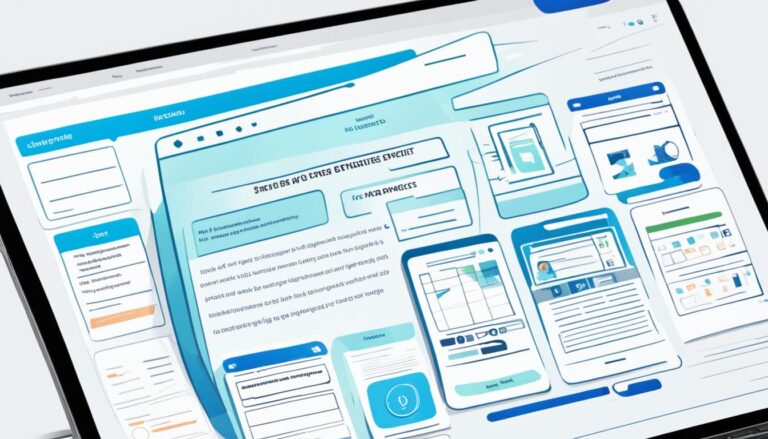Welcome to our guide on cost-friendly AI for businesses! With technology evolving quickly, using AI has become crucial for staying ahead. Yet, many think AI is too pricey, especially for limited budgets.
Good news is, there are ways to use AI without spending too much. Smart investments can boost your returns and bring AI within reach. We’ll share tips and ideas to help control your costs while exploring AI.
We’ll look at the main costs of AI, like hardware and software. Knowing these can help you make clever decisions and save money.
We’ll discuss different AI tools, like chatbots and analytics. Each has its own costs, and understanding them can guide your choices.
We’ll compare making your own AI solutions to buying them ready. Think about what you need, your skills, and how quickly you need it.
We’ll talk about planning your AI budget wisely. You can estimate costs better and find the most efficient way to spend.
By the end, you’ll know how to use AI effectively with a tight budget. The right strategies can improve your business and keep you competitive.
Let’s explore how affordable AI can make a big difference for you!
Types of AI Applications and Their Costs
Artificial Intelligence (AI) is changing many sectors with its various uses. From basic chatbots to advanced self-driving cars, AI can really change how businesses work and boost their efficiency. It’s important to know the different AI applications and what they might cost. This helps companies plan their budgets for AI projects and get good value for their money.
AI Applications
AI offers a wide range of functions and uses. Some common AI applications are:
- Chatbots: These AI-powered helpers provide customer support and talk with users through text. They are the cheapest AI applications and are popular with businesses.
- Predictive Analytics: This tech uses AI to look at past data and make forecasts. It’s used in many fields like finance and healthcare to predict sales, spot fraud, and improve operations.
- Image Recognition: AI systems that recognize images or videos. They enable things like facial recognition, spotting objects, and self-driving cars.
- Natural Language Processing (NLP): NLP lets machines understand human language. Uses include analyzing feelings, translating languages, and voice assistants like Siri and Alexa.
- Recommendation Systems: These AI systems offer personalized suggestions by analyzing user likes and actions. They’re used in online shopping, streaming services, and online content.
- Fraud Detection: AI can spot unusual patterns in big data sets, helping to prevent fraud.
- Robotics: AI in robotics allows robots to do complex tasks on their own or with minimum human help, used in manufacturing, healthcare, and shipping.
- Personalized Marketing: AI solutions that deliver custom marketing campaigns by analyzing customer data, boosting engagement.
- Speech Recognition: These applications change spoken words into written text, powering devices and services that respond to voice commands and offer transcription.
Cost Considerations
The price of creating AI applications depends on how complex they are and what they need. Think about these factors when planning your AI budget:
- Data Acquisition and Preparation: AI needs a lot of different data. Getting and preparing this data can cost more, due to collecting, cleaning, and organizing it.
- Model Development and Testing: Making AI models means designing and improving algorithms. This work needs AI experts and lots of computer power.
- Infrastructure and Maintenance: AI needs strong hardware, like GPUs, and lots of computing power. Keeping everything running and updated also adds to costs.
- Talent and Training: You need to hire and train people like data scientists. The cost varies based on their skills and availability.
Evaluating the costs of AI applications carefully can help businesses decide on their budgets. It’s key to look at the potential profits and make sure the costs match the benefits you expect from AI.
To stay ahead in today’s tech-filled world, using AI can be a game-changer for companies. Knowing about different AI applications and what they could cost is essential for planning your budget and making the most out of AI.
Factors Affecting AI Implementation Costs
Putting AI in place involves several things that add to the project’s total cost. These include the costs for hardware, software, data, and staff. Let’s look closer at each of these parts:
Hardware Costs:
AI algorithms need special hardware like GPUs, FPGAs, and ASICs to run well. These parts boost the AI systems’ power and efficiency. Buying and looking after this hardware costs a lot, which is important for AI work.
Software Costs:
Software is key for AI work. It covers collecting data, analysing it, processing it, and getting licenses. The cost to get and manage software can change. It depends on how complex and big the AI system is.
Data-Related Costs:
Handling data for AI systems costs money too. You need good, useful data to train AI models properly. This includes getting data, storing it, preparing it, and keeping it up to date.
Labor Costs:
You need skilled people like data scientists and software developers for AI projects. The cost for staff is about hiring, training, and keeping a skilled team. They must deal with AI development and its upkeep.
These costs can change based on how big and complex the AI system is. They also vary by industry. Businesses must think about these factors when they plan and budget for AI. This ensures the project is successful and affordable.
Next, we’ll look at the costs of making vs buying AI solutions. We’ll also find ways for organizations to save money.
Building vs. Buying AI Solutions: Cost Considerations
When deciding on AI solutions, organizations must choose between creating their own or using existing tools. They must think about costs and how to use their resources wisely.
Building Custom AI Solutions
Creating a custom AI solution lets companies make something that fits perfectly with their needs. But, this choice can be more expensive and take more time to develop.
Consider the costs of staff, technology, and upkeep when making a custom AI solution. It will need data experts, AI professionals, and software developers to build and run properly.
Making a custom AI solution takes a lot of work in gathering data, training models, and testing. While it allows for full customization, it might not be the best for those with small budgets or tight deadlines.
Using Existing AI Tools and Platforms
Another option is to use ready-made AI tools and platforms. This choice saves money and time because it cuts down on development and maintenance.
Using pre-built AI tools and platforms lets companies save on time and effort. Yet, it might mean less flexibility in customizing the solution.
Companies should think about how much customization they need, budget limits, and how quickly they need to start. Sometimes, mixing custom and pre-built solutions can offer the best value.
The choice between building and buying AI depends on what the organization needs and aims for. By weighing the pros and cons of customization, costs, and time, companies can choose the smartest AI solution.
Effective Budgeting Methods for AI Projects
Organizations have different ways to budget for AI projects. They aim for accurate cost estimations and managing resources well. Two main methods are the top-down approach and the bottom-up approach.
Top-Down Approach
With the top-down method, groups view the AI project from a high level. Then, they break it into smaller pieces. They start with the whole budget for the project. Then, funds are divided among various parts according to their importance.
This strategy gives a clear view of the project’s scope. It aids in strategic decision-making about resources.
Bottom-Up Approach
The bottom-up method, on the other hand, starts with the smallest details. It then adds them up to figure out the costs. Every task and part of the project is looked at one by one. The costs are then calculated and put together to make the total budget.
This method is great for when you need precise cost details. It’s ideal when the project has many parts to consider.
Running a pilot project is also a smart way to budget. It lets organizations test an AI project on a small scale. They can spot challenges early and see how much it might cost. This helps in understanding the return on investment (ROI) and making budget decisions.
Managing the budget well is key to success in AI projects. It means keeping track of spending and how the project is doing. Sharing updates with everyone involved is also crucial. The budget should be checked and adjusted regularly. This ensures the project goes as planned.
In summary, the top-down or bottom-up approach can be chosen based on what the AI project needs. Pilot projects are useful for figuring out costs and testing ideas. Good budget management makes sure AI projects are completed within their budgets.
| Budgeting Methods | Advantages | Disadvantages |
|---|---|---|
| Top-Down Approach | – Provides a high-level view of the project – Helps in making strategic decisions – Efficient allocation of resources |
– May overlook specific cost details – Less accurate in estimating individual components |
| Bottom-Up Approach | – Accurate estimation of costs – Considers granular details of the project – Flexibility in resource allocation |
– Time-consuming process – May overlook the project’s overall scope |
| Pilot Projects | – Provides insights into project feasibility – Helps identify potential challenges – Assesses the ROI |
– Requires additional time and resources – Limited scope of evaluation |
Conclusion
Putting AI to work needs a thorough look at costs. This includes spending on hardware, software, data, staff, and infrastructure. Businesses must weigh the costs of various AI options. They should decide whether to create solutions or use ready-made ones. Knowing costs well can help by using top-down or bottom-up budget approaches. Testing ideas through pilot projects is also smart.
Good budget management is vital from start to finish. It’s about knowing how much AI costs and finding sensible ways to afford it. This means looking into which hardware to buy, software to license, and how to manage data. Also, it includes recruiting and teaching people with the right skills.
If companies manage their AI budgets wisely, they can make the most of it. AI can boost innovation, better operations, and give them an edge over rivals. As AI grows, those who focus on keeping costs in check will thrive in the future digital world.
FAQ
What is the cost range for implementing AI?
AI costs vary a lot. They can start at per month for simple features. For complex solutions, the cost can run into millions.
What are some common types of AI applications and their costs?
There are many AI applications such as chatbots, image recognition, and speech recognition. The cost for each varies based on complexity.
What factors contribute to the overall cost of implementing AI?
Several things affect AI costs including the hardware and software needed. Costs tied to data and paying workers are also important.
Hardware needs can mean buying things like GPUs. Software expenses might cover data analysis. Data itself may need cleaning and managing. Worker costs cover hiring experts like data scientists.
Should I build my own AI solution or use existing tools?
Making your own AI can be better suited to your needs but costs more. Existing AI tools might save time and money but offer less customization. Your choice depends on your specific needs and resources.
What are some effective budgeting methods for AI projects?
Budgeting can be done from the top down or the bottom up. Trying a pilot project can also help with cost estimates. Keeping track of spending during the project is key.
How can organizations maximize their ROI with AI investments?
To maximize ROI, companies should understand AI costs. Employing strategies that save money helps leverage AI within budget and improve returns.


















